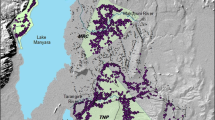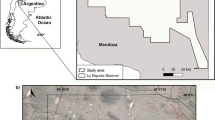Abstract
Since European badgers (Meles meles L.) form non-cooperative groups in parts of their geographic range, but are solitary elsewhere, their social systems have been at the centre of a debate about the evolution of group living in the Carnivora. In a recent review of models of non-cooperative sociality, Woodroffe and Macdonald (1993) presented evidence in favour of two hypotheses, which suggested that badger groups might form because either the distribution of blocks of foodrich habitat, or the economics of excavating new setts, prevented the division of group territories into individual territories. We present data upon the response of badger spatial organisation to a reduction in food-patch dispersion, brought about by the conversion of carthwormpoor arable land to earthworm-rich pasture over a 15-year period. This change in the distribution of earthworm-rich habitats was accompanied by territory fission, facilitated by the excavation of new setts. This indicates that the availability of sett sites had not constrained territory size at the start of the study. However, sett distribution did define the size and configuration of the daughter territories. We also show that variation among territories in the availability of food-rich habitats was reflected in the reproductive rates and body weights of the groups that inhabited them, although there was no detectable effect upon group size.
Similar content being viewed by others
References
Anderson RM, Trewhella W (1985) Population dynamics of the badger (Meles meles) and the epidemiology of bovine tuberculosis (Mycobacterium bovis). Philos Trans R Soc London Ser B 310:327–381
Carr GM, Macdonald DW (1986) The sociality of solitary foragers: a model based on resource dispersion. Anim Behav 34:1540–1549
Cheeseman CL, Harris S (1982) Methods of marking badgers (Meles meles). J Zool London 197:289–292
Cheeseman CL, Mallinson PJ (1980) Radio tracking in the study of bovine tuberculosis in badgers. In: Amlaner CJ, Macdonald DW (eds) A handbook on biotelemetry and radio tracking. Pergamon Oxford, pp 649–656
Cheeseman CL, Wilesmith JW, Ryan J, Mallinson PJ (1987) Badger population dynamics in a high-density area. Symp Zool Soc London 58:279–294
Cheeseman CL, Cresswell WJ, Harris S, Mallinson PJ (1988) Comparison of dispersal and other movements in two badger (Meles meles) populations. Mammal Rev 18:51–59
Cheeseman CL, Mallinson PJ, Ryan J, Wilesmith JW (1993) Recolonisation by badgers in Gloucestershire. In: Hayden TJ (ed) The badger. Royal Irish Academy Dublin
Doncaster CP, Woodroffe R (1993) Den site can determine shape and size of badger territories: implications for group living. Oikos 66:88–93
Edwards CA, Lofty JR (1972) Biology of earthworms. Chapman and Hall, London
Eijsackers HJP (1983) Development of earthworm populations in abandoned arable fields under grazing management. In: Satchell JE (ed) Earthworm ecology. Chapman and Hall, London, pp 241–246
Emlen SJ (1982) The evolution of helping. I. An ecological constraints model. Am Nat 119:29–39
Gittleman JL (1989) Carnivore group living: comparative trends. In: Gittleman JL (ed) Carnivore behavior, ecology and evolution. Cornell University Press, Ithaca, pp 183–207
Harris S, Cresswell WJ (1987) Dynamics of a suburban badger (Meles meles) population. Symp Zool Soc London 58:295–311
Hockin RL (1981) Wytham Woods atlas. Department of Forestry, University of Oxford, Oxford
Hofer H (1986) Patterns of resource dispersion and exploitation of the red fox (Vulpes vulpes) and the Eurasian badger (Meles meles): A comparative study. D Phil thesis, University of Oxford
Hofer H (1988) Variation in resource presence, utilization and reproductive success within a population of European badgers (Meles meles). Mammal Rev 18: 25–36
Kruuk H (1975) Functional aspects of social hunting by carnivores. In: Baerends G, Manning A (eds) Function and evolution in behaviour. Clarendon Press, Oxford, pp 119–141
Kruuk H (1978a) Spatial organization and territorial behaviour of the European badger, Meles meles. J Zool London 184:1–19
Kruuk H (1978b) Foraging and spatial organization of the European badger, Meles meles L. Behav Ecol Sociobiol 4:75–89
Kruuk H, Macdonald DW (1985) Group territories of carnivores: empires and enclaves. In: Sibly RM, Smith RH (eds) Behavioural ecology (Symposia of the British Ecological Society 25). Blackwell Scientific, Oxford, pp 521–536
Kruuk H, Parish T (1982) Factors affecting population density, group size and territory size of the European badger, Meles meles. J Zool London 196:31–39
Kruuk H, Parish T (1983) Seasonal and local differences in the weight of the European badger (Meles meles) in relation to food supply. Z Saugetierk 48:45–50
Kruuk H, Parish T (1985) Food, food availability and weight of badgers (Meles meles) in relation to agricultural changes. J Appl Ecol 22:705–715
Lindström E (1986) Territory inheritance and the evolution of group-living in carnivores. Anim Behav 34: 1825–1835
Lofs-Holmin A (1983) Earthworm population dynamics in different agricultural rotations. In: Satchell JW (ed) Earthworm ecology. Chapman and Hall, London, pp 151–160
Macdonald DW (1980) The red fox, Vulpes vulpes, as a predator of earthworms, Lumbricus terrestris. Z Tierpsychol 52:171–200
Macdonald DW (1983) The ecology of carnivore social behaviour. Nature 301:379–384
Neal E (1986) The natural history of badgers. Croom Helm, London
Parish T, Kruuk H (1982) The uses of radio tracking combined with other techniques in studies of badger ecology in Scotland. Symp Zool Soc London 49:291–299
Roper TJ (1992) Structure and function of badger setts. J Zool London 227:693–694
Roper TJ, Shepherdson DJ, Davies JM (1986) Scent marking with faeces and anal secretion in the European badger (Meles meles): seasonal and spatial characteristics of latrine use in relation to territoriality. Behaviour 97:94–117
Schantz T von (1984) Spacing strategies, kin selection and population regulation in altricial vertebrates. Oikos 42:48–58
Silva J da (1989) Ecological aspects of Eurasian badger social structure, D Phil Thesis, University of Oxford
Woodroffe R (1992) Factors affecting reproductive success in the European badger, Meles meles L. D Phil thesis, University of Oxford
Woodroffe R, Macdonald DW (1993) Badger sociality: models of spatial grouping. Symp Zool Soc London 65:145–169
Author information
Authors and Affiliations
Rights and permissions
About this article
Cite this article
da Silva, J., Woodroffe, R. & Macdonald, D.W. Habitat, food availability and group territoriality in the European badger, Meles meles . Oecologia 95, 558–564 (1993). https://doi.org/10.1007/BF00317441
Received:
Accepted:
Issue Date:
DOI: https://doi.org/10.1007/BF00317441




